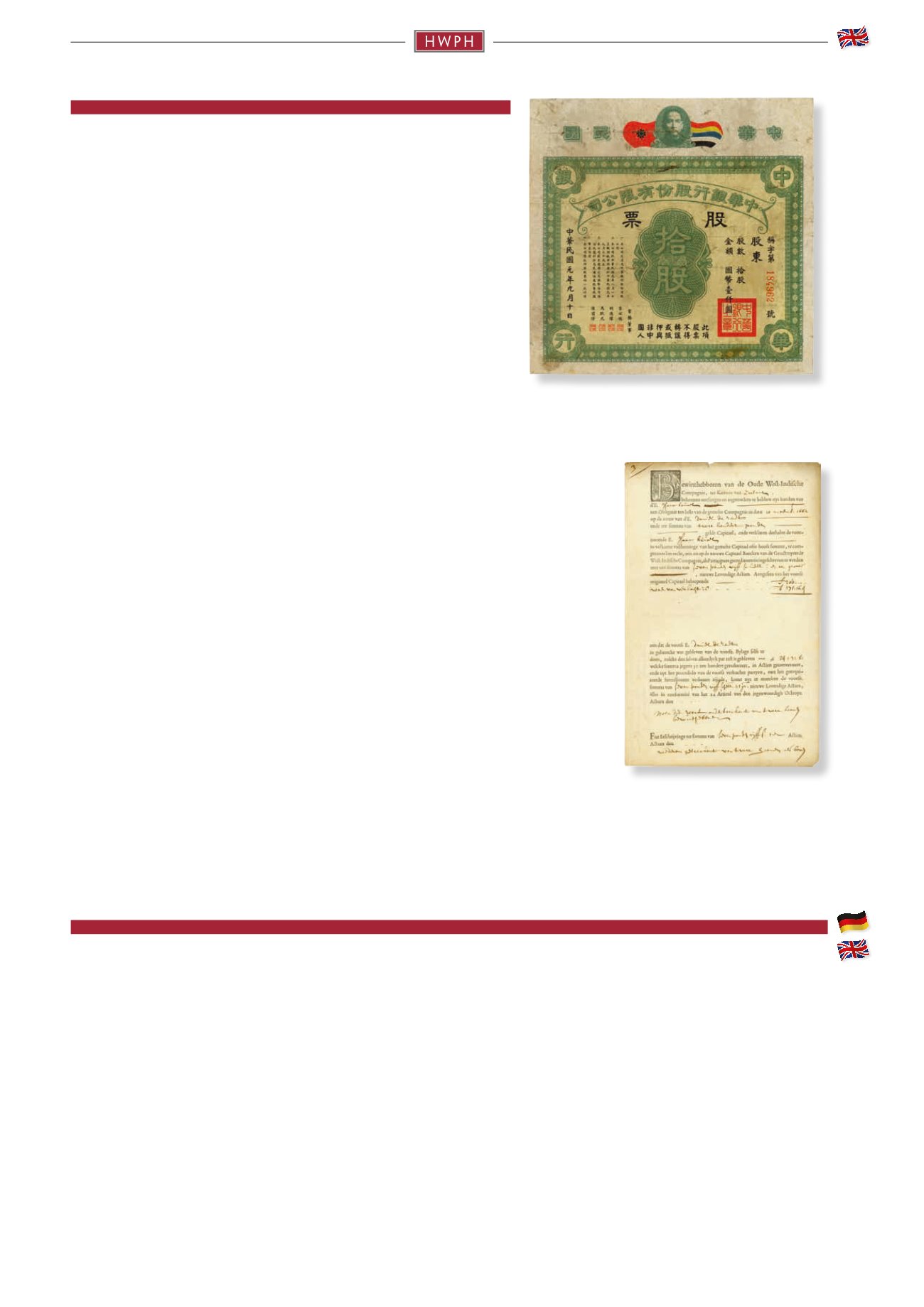

5
Abkürzungen / Abbreviations
Abkürzungen und ihre Bedeutung:
Abb.
= Abbildung = Picture
AG
= Aktiengesellschaft = Joint-stock company
Faks
. = Faksimile-Unterschrift = printed signature
Nr.
= # = Nummer = number
o. D.
= ohne Datum = without date
o. Nr.
= ohne Nummer = without number
RM
= Reichsmark = reichsmark (old German Currency)
OU
= Original-Unterschrift = original signature
KB
= Kuponbogen = all coupons
KR
= Kuponreste = rest of coupons
DB
= Doppelplatt = double sheet of paper
RB
= Reichsbankschatz = Reichsbank Hort
Maße:
Alle Maße sind in cm in der Form Höhe mal Breite angegeben.
All measures mean hight x width (1 cm = 0,3937 inch).
Erhaltungsgrade:
UNC
= uncirculated, neuwertig, vollständig erhalten, ungefaltet,
außer zwischen Mantel und Kuponbogen, Papier sauber (ohne
Flecken), ungelocht usw.
EF
= extremely fine, außerordentlich fein, fast neuwertig, vorzüg-
licher Zustand, sehr leichte Gebrauchsspuren, im Mantel
höchstens einmal gefaltet (dies darf nicht zu streng genommen
werden, denn da die meisten US-Bonds großformatig sind,
wurden sie auf Westentaschenformat gefaltet, dies stellt aber
keine Wertminderung dar).
VF
= very fine, sehr fein, gefaltet, mittlere Gebrauchsspuren,
schwach gefleckt, kleinere Randeinrisse, Klammerlochungen usw.
F
= fine, stärkere Gebrauchsspuren, mehrmals gefaltet, mäßig
starke Flecken, leichte Risse sowie kleinere Fehlstellen in der Falz
möglich usw.
Introduction
We welcome you to our journey through five centuries of financial history. In
this catalogue at hand we present the 50 finest, most interesting, for the econo-
mic development most important and rarest stocks and bonds of our auction.
I invite you to view the TOP 50 items of our auction with another view. What
would the world be like, if our ancestors would not have been such brave inve-
stors and adventurers? What would be the world be like, if it would have not gi-
ven these 50 stock and bond certificates? I know, that it is too much simplified,
but I‘m sure this attitude helps to understand better, what treasures we do hold
in our hands and in our collections.
Let‘s start our journey with the „mother of all joint stock companies“, the V. O.
C. This company issued shares as the first company in the world on 20 March
1602. The V. O. C. shares were the first shares, which were very similar to what
we know today as share certificates. Other companies, founded before, were
only founded for one venture. When the venture was finished, the company
was liquidated. By means of the share capital and the proceedings from bonds
the V. O. C. and the Dutch displaced the Portuguese as the colonial power
number one. The V. O. C. had the monopoly for the area between the Cape of
Good Hope and Western of the Strait of Magellan. The West-India Company
(WIC) was given the monopoly for the trade with Western Africa and America.
The WIC founded cities like New Amsterdam (New York), Brooklyn and Hoboken.
You can see which defining projects and developments were financed by issuing stocks
and bonds. In consideration that only a few hundred or a few thousand certificates of each
issue were printed, the importance of each stock and bond certificate becomes even clearer.
Interesting is a certificate of the Compagnie de New-Yorck. A group of French investors,
with financial backing from Swiss creditors, purchased land in the upper New York State.
They wanted to create a colony for upper class French families fleeing from the tribulati-
ons of the French Revolution. Things developed worse and the bankers changed manage-
ment in a first step, then they liquidated the company.
Even in the communistic China we can find lots of capitalistic contemporary witnesses,
which formed the country. When Dr. Sun Yat-sen came in power in 1912, he gave the right
of issuing papermoney to the Bank of China. The bank had the privilege until 1942.
I invite you to start your own journey through five centuries of financial history. Look out
for parallels to today’s situation. The auction of the 50 highlights will take place on 18 April
2015 starting and 3.30 p.m. in Wuerzburg. Use this unique opportunity and write your
own chapter of financial history.
Sincerely yours,
Matthias Schmitt
Certificate of the OudeWest-Indische
Compagnie, issued in 1662.
Share of the Bank of China, issued in 1912, when the
bank was incorporated. The vignette shows Dr. Sun
Yat-sen, the first President of the Republic.



















